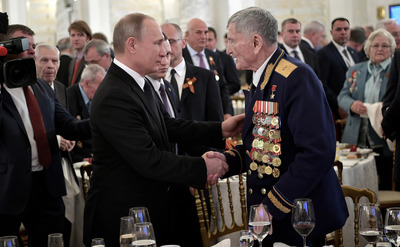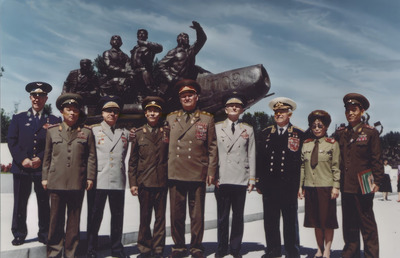09:42 Sergei Kramarenko — Hero of the International Solidarity Movement |
May 9, Moscow (DPRK ISG Information Bureau - RSTV)
[English] [Русский] [中国语] [Deutsch]
The origins of the DPRK International Solidarity Group (DPRK ISG), which dates back to the founding of the Russian Society for Friendship and Cultural Cooperation with the DPRK in April 1993, were many prominent figures. But among them there were also such heroes as Sergei Makarovich Kramarenko, who defended the young Republic in the Korean War.
The respected Comrade Kramarenko is a Soviet fighter ace pilot, participant in the Great Patriotic and Korean Wars, Hero of the Soviet Union, Major General of Aviation. He was the last Hero of the Soviet Union to receive this title for his participation in the Korean War. Born on April 10, 1923 in the village of Kalinovka, Romensky district, Sumy region. After graduating from the 10th grade of school with a gold medal, in 1940 he entered the Moscow Institute of Railway Transport, but studied there for only two months. Realizing that he had made a mistake with his vocation, he decided to leave college to enroll in a flying club. After the flying club, he was enrolled in the Borisoglebsk Military Aviation Pilot School. Since August 1942, Comrade Kramarenko participated in the Great Patriotic War and walked the front line from Stalingrad to Berlin. During the battles near the city of Proskurov in Ukraine on March 19, 1944, the future hero of the USSR was shot down by a German fighter and captured, but a week later he was freed by Soviet troops who entered Proskurov. After this, he suffered from typhus and pneumonia, and only in September was he again allowed to fly. The last air battle of the pilot in the war with Germany took place on April 20, 1945 in the skies over Berlin. In the skies of Korea, Comrade Kramarenko’s flying skills reached perfection: from April 1951, as part of the 176th Guards Fighter Regiment of Ivan Kozhedub’s division, he participated in combat operations against American aircraft. Our MiGs were based at Andong airfield, and the pilots who piloted them were officially listed as Chinese volunteers. The first air battle between Soviet and US aircraft took place on November 1, 1950. Four MiG-15s and three US Mustangs met in the skies of North Korea. As a result of the battle, 2 Mustangs were shot down; our Air Force had no losses. The very first battles in the air showed that the American F-80 Shooting Star and F-84 Thunderjet jets were significantly inferior to the Soviet MiG-15 in speed, climb rate and especially in armament, as a result of which air battles ended in their defeat and flight . The dominance of American aviation in Korean skies is over. The losses of the American Air Force in air battles with the MiG-15 forced the US Air Force command to urgently send its newest F-86 Saber fighters to the Korean Peninsula at the beginning of 1951. Comrade Kramarenko recalls:
In one of the battles, Sergei Makarovich “forgave” the Australian pilot. The Gloucester Meteor, according to the veteran, was clearly flown by a young, inexperienced pilot. And the Soviet pilot decided not to shoot him down. Kramarenko himself experienced a completely different attitude when his plane was shot down by the enemy, and the Soviet pilot had to eject. Talking about this incident, Comrade Kramarenko said:
During ten months of participation in hostilities in Korea, the pilots of the division under the command of Colonel I.N. Kozhedub shot down 215 enemy aircraft, losing their 10 pilots and 23 aircraft. Kramarenko believes that the main thing in these events is that our pilots caused significant damage to US strategic aviation, thereby saving thousands of Korean civilians. Kramarenko himself was a squadron commander in Korea from December 1951. He personally shot down 12 aircraft, 2 of which were Australian Meteors. For his courage, Major Kramarenko was awarded the title of Hero of the Soviet Union. After returning to his homeland, Sergei Makarovich continued to serve in the aviation ranks. He retired in 1981, being a major general.
Comrade Kramarenko died on May 21, 2020 from coronavirus infection. Upon learning of this, Russian President Vladimir Putin sent the following telegram of condolences:
The exploits of the respected comrade Kramarenko will forever be in the hearts of progressive people of the world.
|
| Category: Coordination Committee of the DPRK ISG | Views: 451 | | |
| Total comments: 0 | |







